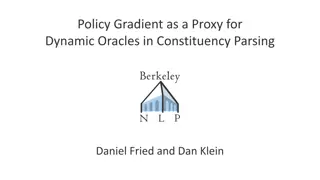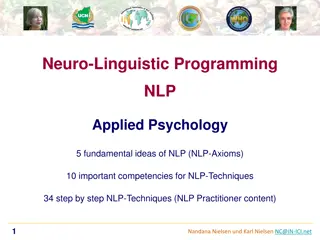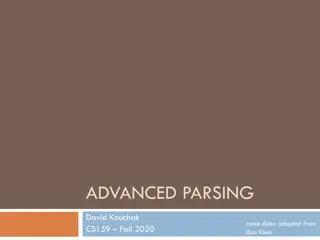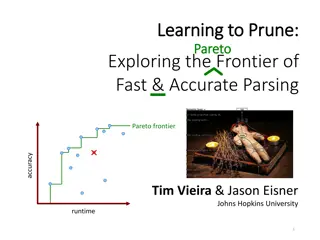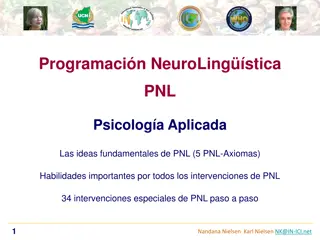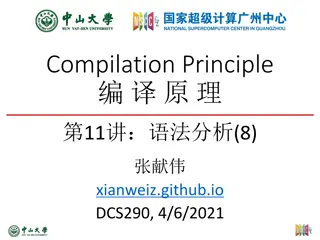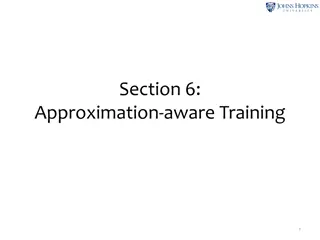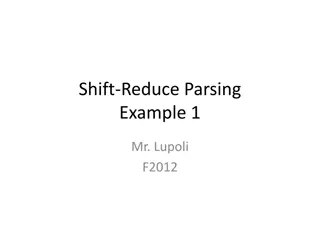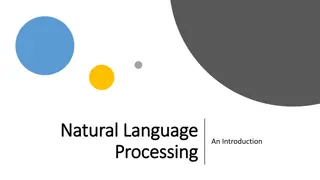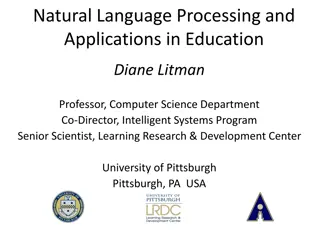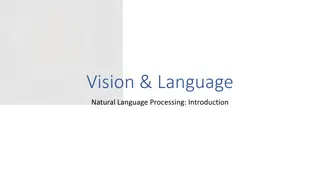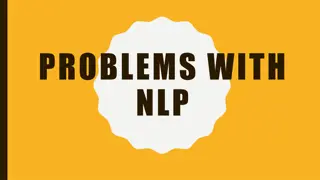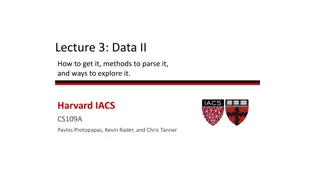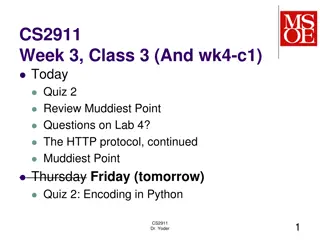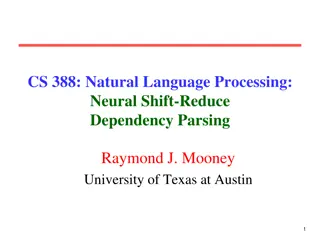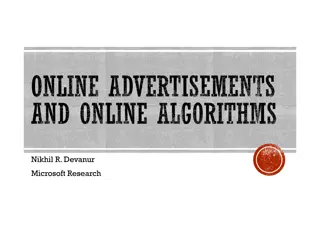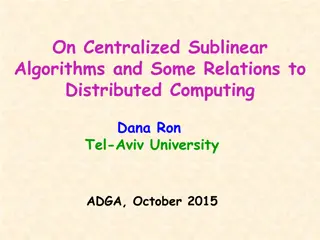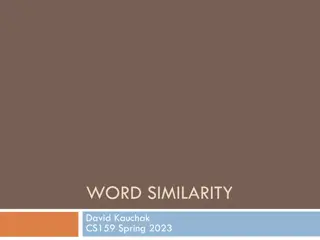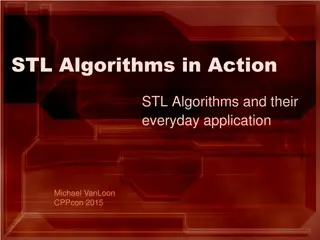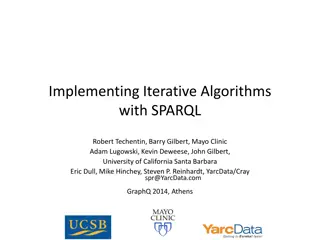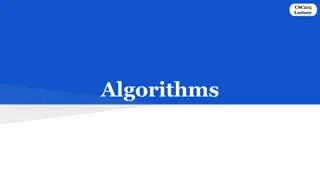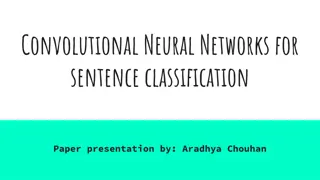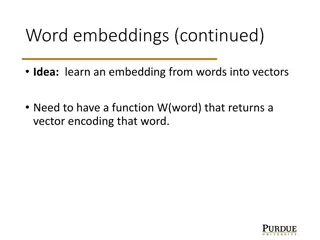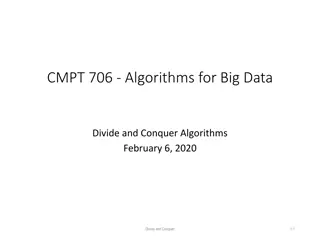Introduction to NLP Parsing Techniques and Algorithms
Delve into the world of Natural Language Processing (NLP) with a focus on parsing techniques like Cocke-Kasami-Younger (CKY) and Chart Parsing. Explore challenges such as left recursion and dynamic programming in NLP, along with detailed examples and explanations of the CKY Algorithm.
Download Presentation

Please find below an Image/Link to download the presentation.
The content on the website is provided AS IS for your information and personal use only. It may not be sold, licensed, or shared on other websites without obtaining consent from the author. Download presentation by click this link. If you encounter any issues during the download, it is possible that the publisher has removed the file from their server.
E N D
Presentation Transcript
Introduction to NLP Cocke-Kasami-Younger (CKY) Parsing
Notes on Left Recursion Problematic for many parsing methods Infinite loops when expanding But appropriate linguistically NP -> DT N NP -> PN DT -> NP s Mary s mother s sister s friend
Chart Parsing Top-down parsers have problems with expanding the same non-terminal In particular, pre-terminals such as POS Bad idea to use top-down (recursive descent) parsing as is Bottom-up parsers have problems with generating locally feasible subtrees that are not viable globally Chart parsing will address these issues
Dynamic Programming Motivation A lot of the work is repeated Caching intermediate results improves the complexity Dynamic programming Building a parse for a substring [i,j] based on all parses [i,k] and [k, j] that are included in it. Complexity O(n3) for recognizing an input string of length n
Dynamic Programming CKY (Cocke-Kasami-Younger) bottom-up requires a normalized (binarized) grammar Earley parser top-down more complicated (separate lecture)
CKY Algorithm function cky (sentence W, grammar G) returns table for i in 1..length(W) do table[i-1,i] = {A|A->Wi in G} for j in 2..length(W) do for i in j-2 down to 0 do for k in (i+1) to (j-1) do table[i,j] = table[i,j] union {A|A->BC in G, B in table [I,k], C in table [k,j]} If the start symbol S is in table [0,n] then W is in L(G)
Example ["the", "child", "ate", "the", "cake", "with", "the", "fork"] S -> NP VP NP -> DT N | NP PP PP -> PRP NP VP -> V NP | VP PP DT -> 'a' | 'the' N -> 'child' | 'cake' | 'fork' PRP -> 'with' | 'to' V -> 'saw' | 'ate'
the child ate the cake with the fork
DT the child ate the cake with the fork
DT the N child ate the cake with the fork
DT NP the N child ate the cake with the fork
DT NP the N child ate the cake with the fork
DT NP the N child V ate the cake with the fork
DT NP the N child V ate DT the cake with the fork
DT NP the N child V ate DT the N cake with the fork
DT NP the N child V ate NP DT the N cake with the fork
DT NP the N child V ate NP DT the N cake with the fork
DT NP the N child V VP ate NP DT the N cake with the fork
DT NP the N child V VP ate NP DT the N cake with the fork
DT NP S the N child V VP ate NP DT the N cake with the fork
DT NP S the N child V VP ate NP DT the N cake with the fork
DT NP S the N child V VP ate NP DT the N cake PRP with the fork
DT NP S the N child V VP ate NP NP DT the N cake PRP PP with NP DT the N fork
DT NP S the N child V VP VP ate NP NP DT the N cake PRP PP with NP DT the N fork
DT NP S the N child V VP VP ate NP NP DT the N cake PRP PP with NP DT the N fork
S DT NP S the N child V VP VP ate NP NP DT the N cake PRP PP with NP DT the N fork
S DT NP S the N child V VP VP ate NP NP DT the N cake [0] DT [1] N [2] ==> [0] NP [2] [3] DT [4] N [5] ==> [3] NP [5] [6] DT [7] N [8] ==> [6] NP [8] [2] V [3] NP [5] ==> [2] VP [5] [5] PRP [6] NP [8] ==> [5] PP [8] [0] NP [2] VP [5] ==> [0] S [5] [3] NP [5] PP [8] ==> [3] NP [8] [2] V [3] NP [8] ==> [2] VP [8] [2] VP [5] PP [8] ==> [2] VP [8] [0] NP [2] VP [8] ==> [0] S [8] PRP PP with NP DT the N fork
(S (NP (DT the) (N child)) (VP (VP (V ate) (NP (DT the) (N cake))) (PP (PRP with) (NP (DT the) (N fork)))))
(S (NP (DT the) (N child)) (VP (VP (V ate) (NP (DT the) (N cake))) (PP (PRP with) (NP (DT the) (N fork))))) (S (NP (DT the) (N child)) (VP (V ate) (NP (NP (DT the) (N cake)) (PP (PRP with) (NP (DT the) (N fork))))))
Complexity of CKY Space complexity There are O(n2) cells in the table Single parse Each cell requires a linear lookup. Total time complexity is O(n3) All parses Total time complexity is exponential
A longer example ["take", "this", "book"] S -> NP VP | Aux NP VP | VP NP -> PRON | Det Nom Nom -> N | Nom N | Nom PP PP -> PRP NP VP -> V | V NP | VP PP Det -> 'the' | 'a' | 'this' PRON -> 'he' | 'she' N -> 'book' | 'boys' | 'girl' PRP -> 'with' | 'in' V -> 'takes' | 'take'
Non-binary productions ["take", "this", "book"] S -> NP VP | Aux NP VP | VP NP -> PRON | Det Nom Nom -> N | Nom N | Nom PP PP -> PRP NP VP -> V | V NP | VP PP Det -> 'the' | 'a' | 'this' PRON -> 'he' | 'she' N -> 'book' | 'boys' | 'girl' PRP -> 'with' | 'in' V -> 'takes' | 'take'
Chomsky Normal Form (CNF) All rules have to be in binary form: X Y Z or X w This introduces new non-terminals for hybrid rules n-ary rules unary rules epsilon rules (e.g., NP ) Any CFG can be converted to CNF See Aho & Ullman p. 152
ATIS grammar Original version S NP VP S Aux NP VP S VP NP Pronoun NP Proper-Noun NP Det Nominal Nominal Noun Nominal Nominal Noun Nominal Nominal PP VP Verb VP Verb NP VP VP PP PP Prep NP From Jurafsky and Martin
ATIS grammar in CNF Original version CNF version S NP VP S Aux NP VP S NP VP S X1 VP X1 Aux NP S book | include | prefer S Verb NP S VP PP NP I | he | she | me NP Houston | NWA NP Det Nominal Nominal book | flight | meal | money Nominal Nominal Noun Nominal Nominal PP VP book | include | prefer VP Verb NP VP VP PP PP Prep NP S VP NP Pronoun NP Proper-Noun NP Det Nominal Nominal Noun Nominal Nominal Noun Nominal Nominal PP VP Verb VP Verb NP VP VP PP PP Prep NP
ATIS grammar in CNF Original version CNF version S NP VP S Aux NP VP S NP VP S X1 VP X1 Aux NP S book | include | prefer S Verb NP S VP PP NP I | he | she | me NP Houston | NWA NP Det Nominal Nominal book | flight | meal | money Nominal Nominal Noun Nominal Nominal PP VP book | include | prefer VP Verb NP VP VP PP PP Prep NP S VP NP Pronoun NP Proper-Noun NP Det Nominal Nominal Noun Nominal Nominal Noun Nominal Nominal PP VP Verb VP Verb NP VP VP PP PP Prep NP
Chomsky Normal Form All rules have to be in binary form: X Y Z or X w New non-terminals for hybrid rules, n-ary and unary rules: INF-VP to VP becomes INF-VP TO VP TO to S Aux NP VP becomes S R1 VP R1 Aux NP S VP VP Verb VP Verb NP VP Verb PP becomes S book S buy S R2 PP S Verb PP etc.
Issues with CKY Weak equivalence only Same language, different structure If the grammar had to be converted to CNF, then the final parse tree doesn t match the original grammar However, it can be converted back using a specific procedure Syntactic ambiguity (Deterministic) CKY has no way to perform syntactic disambiguation
Notes Demo: http://lxmls.it.pt/2015/cky.html Recognizing vs. parsing Recognizing just means determining if the string is part of the language defined by the CFG Parsing is more complicated it involves producing a parse tree


